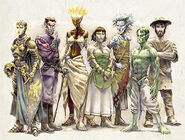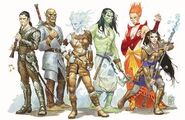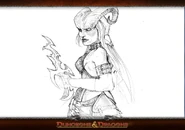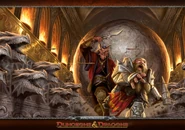Tieflings were human-based planetouched, native outsiders that were infused with the touch of the fiendish planes, most often through descent from fiends—demons, Yugoloths, devils, evil deities, and others who had bred with humans.[7] Tieflings were known for their cunning and personal allure, which made them excellent deceivers as well as inspiring leaders when prejudices were laid aside.[8]
Although their evil ancestors could be many generations removed, the taint lingered. Unlike half-fiends, tieflings were not predisposed to evil alignments and varied in alignment nearly as widely as full humans, though tieflings were certainly devious.[9] The celestial counterparts of tieflings were called aasimar.[10]
Similar races included fey'ri, maeluth, tanarukk, and wisplings.[citation needed]
Description
Tieflings tended to have an unsettling air about them, and most people were uncomfortable around them, whether they were aware of the tiefling's unsavory ancestry or not. While some looked like normal humans, most retained physical characteristics derived from their ancestor, with the most common such features being horns, prehensile tails, and pointed teeth. Some tieflings also had eyes that were solid orbs of black, red, white, silver, or gold, while others had eyes more similar to those of humans.[11] Other, more unusual characteristics included a sulfurous odor, cloven feet, or a general aura of discomfort they left on others.[7]
In many other ways, tieflings were similar to humans physically. Tieflings were, on average, just as tall as humans, from 5'6" – 6'2" (1.67 – 1.88 m) and weighed just a little bit heavier at 140 – 220 lbs (64 – 91 kg). Tiefling skin was usually human-like in color, though extending past normal human colors into reddish hues as well. Tiefling hair was also often the same color as human hair, though dark blue, red, or purple were common shades amongst the race.[11] Although it was not always the case, tieflings tended to have better reflexes than their human kin. This, along with their natural propensity for hiding and deceit helped to give tieflings a reputation for thievery and duplicity.[7]
Tieflings who had strikingly inhuman features were often killed at birth by their horrified parents or others. Only those tieflings with subtle features or born to someone indifferent to their appearance, either out of acceptance or cruel purpose, were likely to reach adulthood.[12] Those tieflings who did reach adulthood could be expected to age at roughly the same rate.[9] They had life spans roughly 20 to 40 years longer than normal humans.[4]
Tiefling bloodlines
The physical appearance of a tiefling often depended on the exact ancestry that spawned it, a bloodline that might have remained dormant for generations. Diabolic or demonic tieflings could, besides the common horns and tails, possess a forked tongue, leathery or scaly skin, the smell of brimstone, or unusually warm flesh. Some accounts even held these tieflings to cast neither shadows nor reflections. Some diabolic tieflings also sported goat-like legs or hooves. Tieflings descended from rakshasa might have furred skin or feline eyes. Most tieflings had only one or two of these features.[13]
Some tieflings were not descended from mere fiends at all, but from powerful gods. These tieflings often had their own physical characteristics that set them apart. Tieflings sired by Beshaba, for instance, often had antlers instead of horns and pale, white hair. Those sired by Mask, on the other hand, were known for their tendency to cast no reflection.[14]
In Mulhorand, the most common tieflings were often those spawned from a union with Sseth or Sebek. Most tieflings were, however, the grandchildren or even great-grandchildren of fiends and in Mulhorand's neighbor, Thay, most tieflings were spawned deliberately by powerful wizards as part of some elaborate plot for power.[9]
In 1358 DR, a warlock coven known as the Toril thirteen performed a ritual that cursed most tiefling lineages—those of demons, devils, hags, and rakshasas, among others—with the "blood of Asmodeus", changing their original lineage with that of the archdevil himself. This was done to make Asmodeus a "racial god", ensuring him enough followers to attain godly powers.[15] After the Spellplague of 1385 DR, when Asmodeus became a god, the magic of the ritual took effect across all of Toril and afterwards most tieflings living in the 15th century DR were of the Asmodean lineage, all having a similar devilish appearance.[16]
Prior to Asmodeus's ascension to godhood, the infernal blood could be diluted through intermarriage, but afterward, the union of a tiefling with another race always produced a tiefling child.[17]
In the late years of the 15th century, tieflings of other bloodlines began to born again, but the Asmodean lineage was still the most numerous by a wide margin at the time.[16]
Abilities
Tieflings had a number of abilities gifted to them by their fiendish heritage. By and large, tieflings were alluring and intelligent creatures, with a seductive aura in spite of their obviously evil ancestry. To a large degree, tieflings were more capable of guile than a great number of races, but these were not their dominant qualities. Tieflings also had an innate resistance to heat and had a hint of bloodlust that gave them a slight edge in combat. Tieflings also had access to an ability known as infernal wrath, which channeled their innate rage and potential for evil into their attacks for added effectiveness.[8] Some tieflings also learned to unlock their fiendish potential further, sprouting wings such as those borne by many fiends.[18]
Some tieflings also had the innate ability to cast a darkness spell, though not all of the race exhibited this trait.[7]
Personality
Most tieflings were aware from an early age that they were different from others around them, and were given to strange urges and desires because of their unusual ancestry. Few tieflings were raised with the love a normal human child might expect to receive and this shaped most of the race into bitter individuals who expected eventual rejection from all whom they meet. While some would follow this path towards evil, others rejected it wholeheartedly and sought to make a good impact on the world around them, sometimes becoming the most heroic characters of all. Few could maintain this discipline however, and most tieflings fell somewhere between both extremes.[9]
Because tieflings were generally distrusted throughout the world, owing to their fiendish heritage, many were themselves distrusting and self-reliant.[11] Tieflings were also proud and secretive by nature and possessed a dark demeanor.[19] Unfortunately, this only helped to further the reputation tieflings had for being social outcasts and untrustworthy scoundrels. However, members of other races would find that once they demonstrated friendship and trust towards a tiefling, it would quickly be reciprocated in full. Once that bond was forged, it was rarely broken.[11]
Culture
Like other races that were the result of the breeding of two or more others, tieflings had no true culture they could call their own. However, there were many archetypal features of tieflings that were not necessarily innate. This include their attitude regarding their heritage, and while some tieflings embraced it, others were repulsed by it, forging the two most common stereotypes of tieflings.[19]
The former tieflings, who were proud of their fiendish past, were often fascinated by the dark and sinister events that touched the world, but were not necessarily evil or inclined to perpetuate them. Some tieflings of this type chose to use their knowledge of evil and their own fiendish abilities to thwart these dark plots and schemes. Others sought to learn more and to emulate these evil deeds.[19]
Other tieflings were ashamed or even frightened of their heritage and wished only to escape the shadow that lurked over them as a result. Some did this through constantly doing good, as though to make up for the evil that begot them. Others instead hid and tried to go unnoticed as they passed through the world, preferring to be ignored and forgotten than noticed and made a target because of their past.[19]
Regardless of their motivations, tieflings often distrusted one another, sometimes even casting the same preconceptions on one another that others did on them. In spite of this, many secretly desired to have another tiefling nearby, if only to experience some small kind of kinship. Some of these tieflings gathered as partners-in-crime, while others were sought out by good tieflings who hoped to redeem others of their race.[9]
Magic and religion
Those tieflings who sought power through arcane magic were most often warlocks.[8] Tiefling arcane spellcasters of all kinds, however, felt a draw towards the fiendish energies of the planes and tiefling wizards commonly specialized as diviners for the purposes of seeking knowledge of the Lower Planes or as conjurers so that they might summon the dark spirits whom they called kin.[9]
Those tieflings who were religious were a varied lot, since no god held more sway over tieflings than any other, though Asmodeus, as the lord over the fiendish race of devils, may come close. Most tieflings called on one of the primary gods of their homeland, though there were exceptions. Beshaba, the goddess of bad luck, for instance, appealed to many of the race, owing to tieflings' collective sense of misfortune. Many evil tieflings who channeled their dark emotions into aggression often found themselves in the service of Cyric, as well. Prior to the Spellplague and the god's subsequent disappearance, Gargauth also drew a large number of worshipers seeking vengeance, as did Mask, who gathered tiefling thieves to his church. Shar, like Gargauth, appealed to those with a taste for vengeance.[14]
Relations with other races
Tieflings, in general, didn't get along well with the other races of the world and were slow to trust others of any race, even their own. This animosity that tieflings had for others was taken to its extreme in the case of aasimar, whom tieflings instinctively feared or loathed. Devas often had a similar reaction, making it difficult for members of either race to successfully interact with each other. Of all the common races, tieflings felt the most kinship with half-orcs, who were similarly a target of revulsion and hate.[14]
Homelands
Being the result of fiendish interference with humans, tieflings had no true homeland and were found throughout Toril. The race was particularly common, however, in Mulhorand and Unther before both nations were devastated by the Spellplague,[19] though the latter's population was said to have been vastly exaggerated.[9] Tieflings also once had a large presence in Thay, where many were slaves. Tieflings who were discovered in the land often became pawns in the struggles between Thay's zulkirs, whom they served as assassins, thieves, and spies.[9] The takeover by Szass Tam, however drove many out of the region.[19]
In the 15th century, tieflings were most commonly found in Narfell, where the race was believed to have first appeared in ancient times,[5] and High Imaskar, though many were also welcome in Tymanther, thanks to the native dragonborns' policy of racial tolerance. Other tieflings allied themselves with the genasi servants of Memnon in Calimshan, where they were a valued addition to the efreeti's war against his rival Calim. Many tieflings were also found along the Sword Coast, particularly in the cosmopolitan Baldur's Gate, as well as parts of the Dragon Coast. In Aglarond, the race was only begrudgingly tolerated as enemies of Thay.[19]
Appendix
Gallery
Further Reading
- Monte Cook (1996). The Planewalker's Handbook. Edited by Michele Carter. (TSR). ISBN 978-0786904600.
- Template:Cite book/Monster Manual
External Links
 Tiefling article at the Eberron Wiki, a wiki for the Eberron campaign setting.
Tiefling article at the Eberron Wiki, a wiki for the Eberron campaign setting. Tiefling article at Wikipedia, The Free Encyclopedia.
Tiefling article at Wikipedia, The Free Encyclopedia.
References
- ↑ 1.0 1.1 1.2 1.3 1.4 1.5 1.6 Mike Mearls, Jeremy Crawford (2014). Player's Handbook 5th edition. (Wizards of the Coast), pp. 42–43. ISBN 978-0-7869-6560-1.
- ↑ 2.0 2.1 Mike Mearls, Stephen Schubert, James Wyatt (June 2008). Monster Manual 4th edition. (Wizards of the Coast), p. 250. ISBN 978-0-7869-4852-9.
- ↑ 3.0 3.1 3.2 3.3 Skip Williams, Jonathan Tweet, Monte Cook (July 2003). Monster Manual v.3.5. (Wizards of the Coast), pp. 209–210. ISBN 0-7869-2893-X.
- ↑ 4.0 4.1 Richard Baker, James Wyatt (March 2004). Player's Guide to Faerûn. (Wizards of the Coast), p. 31. ISBN 0-7869-3134-5.
- ↑ 5.0 5.1 Richard Baker (January 3rd, 2008). The one and only "Ask the Realms authors/designers thread" 3. Retrieved on January 9th, 2009.
- ↑ 6.0 6.1 Mike Mearls, Jeremy Crawford (2014). Player's Handbook 5th edition. (Wizards of the Coast), p. 121. ISBN 978-0-7869-6560-1.
- ↑ 7.0 7.1 7.2 7.3 Ed Greenwood, Sean K. Reynolds, Skip Williams, Rob Heinsoo (June 2001). Forgotten Realms Campaign Setting 3rd edition. (Wizards of the Coast), p. 20. ISBN 0-7869-1836-5.
- ↑ 8.0 8.1 8.2 Rob Heinsoo, Andy Collins, James Wyatt (June 2008). Player's Handbook 4th edition. (Wizards of the Coast), p. 48. ISBN 0-7869-4867-1.
- ↑ 9.0 9.1 9.2 9.3 9.4 9.5 9.6 9.7 Reynolds, Forbeck, Jacobs, Boyd (March 2003). Races of Faerûn. (Wizards of the Coast), p. 126. ISBN 0-7869-2875-1.
- ↑ Ed Greenwood, Sean K. Reynolds, Skip Williams, Rob Heinsoo (June 2001). Forgotten Realms Campaign Setting 3rd edition. (Wizards of the Coast), p. 19. ISBN 0-7869-1836-5.
- ↑ 11.0 11.1 11.2 11.3 Rob Heinsoo, Andy Collins, James Wyatt (June 2008). Player's Handbook 4th edition. (Wizards of the Coast), p. 49. ISBN 0-7869-4867-1.
- ↑ Reynolds, Forbeck, Jacobs, Boyd (March 2003). Races of Faerûn. (Wizards of the Coast), p. 125. ISBN 0-7869-2875-1.
- ↑ Reynolds, Forbeck, Jacobs, Boyd (March 2003). Races of Faerûn. (Wizards of the Coast), pp. 125–126. ISBN 0-7869-2875-1.
- ↑ 14.0 14.1 14.2 Reynolds, Forbeck, Jacobs, Boyd (March 2003). Races of Faerûn. (Wizards of the Coast), p. 127. ISBN 0-7869-2875-1.
- ↑ Erin M. Evans (2016). The Devil You Know. (Wizards of the Coast), pp. 262–264. ISBN 978-0786965946.
- ↑ 16.0 16.1 Steve Kenson, et al. (November 2015). Sword Coast Adventurer's Guide. Edited by Kim Mohan. (Wizards of the Coast), p. 118. ISBN 978-0-7869-6580-9.
- ↑ Template:Cite digital book/Brimstone Angels: Lesser Evils/Kindle
- ↑ Rob Heinsoo, David Noonan, Robert J. Schwalb, Chris Sims (November 2008). Martial Power. (Wizards of the Coast), p. 63. ISBN 978-0-7869-4981-6.
- ↑ 19.0 19.1 19.2 19.3 19.4 19.5 19.6 Rob Heinsoo, Logan Bonner, Robert J. Schwalb (September 2008). Forgotten Realms Player's Guide. (Wizards of the Coast), p. 19. ISBN 978-0-7869-4929-8.
Connections
Maztica: Azuposi • Dog People • Green Folk • Metahel • Nahopaca • Nexalan • Payit (Itza)
Taan: Commani, Dalat, Fankiang, Gur, Guychiang, Igidujin, Kashghun, Khassidi, Naican, Oigur, Pazruki, Quirish, T'aghur, Tsu-tsu, Tuigan, Zamogedi
Kara-Tur & Malatra: Bavanese & Bertanese • Bawani • Han • Issacortae • Koryoan • Kozakuran • Kuong • Nubari (Huroola • Koshiva • Kukalatu • Wise Ones • Zantira) • Pazruki • Purang • Seng • Shou • Tabotan • Tayanulchi • Wanese • Wu-haltai
Zakhara: Zakharan
| Devil (lawful evil) |
Yugoloth (Daemon) (neutral evil) | Gehreleth (Demodand) (neutral evil) | Demon (chaotic evil) |
Other Fiends
Achaierai • Barghest • Canomorph (Haraknin • Shadurakul) • Hell hound • Hordling • Howler • Larva • Maelephant • Marrashi • Night hag • Nightmare • Rakshasa (Ak'chazar • Naztharune) • Succubus • Vargouille • Yeth hound
Fiendish creature • Half-fiend (Alu-fiend • Cambion • Draegloth • Durzagon) • Tiefling (Fey'ri • Maeluth • Tanarukk)




